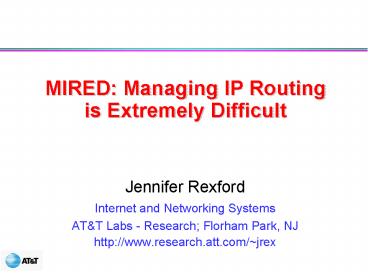MIRED: Managing IP Routing is Extremely Difficult
Title:
MIRED: Managing IP Routing is Extremely Difficult
Description:
Self-configuring (no global registry of topology) Stateless (limited information in the routers) ... Accounting for uncertainty (randomization, non-determinism) ... –
Number of Views:37
Avg rating:3.0/5.0
Title: MIRED: Managing IP Routing is Extremely Difficult
1
MIRED Managing IP Routing is Extremely Difficult
- Jennifer Rexford
- Internet and Networking Systems
- ATT Labs - Research Florham Park, NJ
- http//www.research.att.com/jrex
2
Outline
- Operational view of IP routing
- Autonomous Systems and IP routing
- Challenges of managing IP routing protocols
- Managing IP routing
- Detecting/fixing problems
- Traffic engineering
- Router configuration
- Limitations on routing management
- Common challenges across management tasks
- Thoughts on how the Knowledge Plane can help
3
IP Networks
- IP networks are
- Decentralized (loose confederation of Autonomous
Systems) - Self-configuring (no global registry of topology)
- Stateless (limited information in the routers)
- Connectionless (no fixed connection between
hosts) - These attributes contribute
- To the success of IP networks
- To the rapid growth of the IP networks
- and the difficulty of controlling IP networks!
4
Interdomain Routing Border Gateway Protocol
- ASes exchange info about who they can reach
- IP prefix block of destination IP addresses
- AS path sequence of ASes along the path
- Policies configured by the ASs network operator
- Path selection which of the paths to use?
- Path export which neighbors to tell?
I can reach 12.34.158.0/24 via AS 1
I can reach 12.34.158.0/24
1
2
3
12.34.158.5
5
Intradomain Routing OSPF or IS-IS
- Shortest path routing based on link weights
- Routers flood the link-state information to each
other - Routers compute the next hop to reach other
routers - Weights configured by the ASs network operator
- Simple heuristics link capacity or physical
distance - Traffic engineering tuning the link weights to
the traffic
6
Routing Management Problems
- Routing anomalies
- Hijacked routes misdirected/lost traffic
- Blackholes unreachable destination hosts
- Route flapping unstable routes, links, peers,
- Convergence transient delay, loss, and
reordering - Overloaded routers
- CPU/bandwidth processing the routing messages
- Memory storing the routing and forwarding tables
- Unpredictable routing after network changes
- Topology failures, maintenance, new link,
- Configuration BGP policies, OSPF weights,
7
Routing Management Challenges
- Router configuration
- Languages non-standard assembly language
- Granularity individual routers not a network
- Tools limited tools for automated provisioning
- Legacy existing manually-configured networks
- Routing constraints
- Performance limit congestion and end-to-end
latency - Stability avoid/minimize route convergence delay
- Financial minimize total charges based on usage
- Legal adhere to customer SLAs and peering
contracts
8
Operator Tasks Prevent/Diagnose Problems
- Identifying hijacked BGP routes
- Detect BGP routes for your addresses announced by
other ASes - Monitor BGP updates from outside vantage points
- Preventative filtering of bogus routes
- Filter BGP advertisements from customers based on
AS path - Analyze BGP routes to infer AS provider-customer
relationships - Root-cause analysis (routing level)
- Determine location and cause of a sequence of BGP
route updates - Data-mine BGP update messages from multiple
vantage points - Root-cause analysis (forwarding level)
- Determine location and cause of anomalies in the
data path - Combine traceroute probes with BGP-derived
IP-to-AS mapping
9
Operator Tasks Traffic Engineering
- Predict effects of routing changes (intradomain)
- Model effects of changing OSPF/IS-IS link weights
- Capture how traffic leaves the AS to other
domains - Measure current topology, routing, and traffic
matrix - (Also incorporate fate-sharing of IP links at the
transport level) - Predict effects of routing changes (interdomain)
- Model effects of changing BGP routing policies
- Avoid changes that have uncontrollable side
effects - Measure current traffic volumes destined to each
IP prefix - (Any ways for neighboring ASes to coordinate
their efforts???) - Select good ways to tune the routing parameters
- Codify the many operational constraints in
objective function - Search for good changes to the routing
configuration
10
Operator Tasks Router Configuration
- Assess configuration of existing network
- Check for errors and visualize the network design
- Reverse engineer the configuration templates
rules - Collect, parse, join the router configuration
files - Verify key properties of routing system
- Ensure consistent BGP policies and route filters
- Apply sufficient condition tests for
convergence within an AS - Analyze configuration files and BGP/OSPF messages
- (Any way to support multi-AS BGP checks?)
- Automate router provisioning
- Codify technical questionnaire, data model, and
template/rules - Drive router provisioning directly from the
database - (Any way to support multi-AS routing
configuration?)
11
Key Ingredients of Per-AS Routing Management
- Network measurements
- Topology, configuration, routing, traffic, and
performance - Multiple types of measurement data and many
vantage points - Construct an AS-wide view to detect, diagnose,
and fix - Multiple domains of control
- Protective filtering at boundaries between
domains - Detecting and diagnosing problems via measurement
- Limiting and predicting side effects on other
domains - Accurate predictive models
- What-if models for traffic engineering,
capacity planning, etc. - Accounting for uncertainty (randomization,
non-determinism) - Sufficient-condition checks for routing
convergence properties
12
Implications on the Knowledge Plane
- Sensors IP measurement platform
- Multiple kinds of data from multiple vantage
points - On-demand probing to aid in troubleshooting
- Formats, time base, APIs, views, event
notification, etc. - Analysis multi-AS routing management
- Data mining/inference to diagnose routing
anomalies - Consistency checking of interdomain routing
policies - Support for end-to-end provisioning of routing
protocols - Actuators multi-AS control actions
- Predicting effects of routing/topology changes
- Inter-AS interaction to coordinate routing
changes - Balance between coordination and independence































